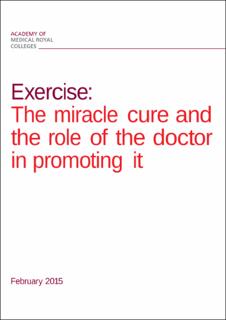| dc.description.abstract | The big four “proximate” causes of preventable ill-health are: smoking, poor nutrition, lack of physical activity and alcohol excess. Of these, the importance of regular exercise is the least well-known. Relatively low levels of increased activity can make a huge difference. All the evidence suggests small amounts of regular exercise (five times a week for 30 minutes each time for adults) brings dramatic benefits. The exercise should be moderate – enough to get a person slightly out of breath and/or sweaty, and with an increased heart rate. This report is a thorough review of that evidence.
Regular exercise can prevent dementia, type 2 diabetes, some cancers, depression, heart disease and other common serious conditions – reducing the risk of each by at least 30%. This is better than many drugs.
The need to encourage individuals to participate in physical activity has never been greater. Half the population do not reach this level of activity, with wide variations between groups, sufficient to cause ill-health. The costs of physical inactivity to the UK, the NHS and other public bodies are estimated to be in excess of £15bn.
There are greater intangible costs too, to individuals, families and communities. In the UK now, lack of physical activity is acknowledged as one of the top four factors responsible for premature deaths and long-term diseases, and also as a key mechanism for large inequalities in health. These factors (smoking, nutrition, lack of physical activity and alcohol) are often described as lifestyle choices, yet many people do not have the finances, self-efficacy, environment or knowledge to be able to exercise lifestyle “choices”. These are the mechanisms by which inequalities develop. This report is about targeting just one of these factors.
Doctors are increasingly being asked to carry out a range of interventions when they see patients, including screening and changing behaviour, with initiatives such as ‘Make Every Contact Count’. However this report calls on doctors to promote the benefits of regular physical activity to their patients and to communities in their wider roles as ‘advocates for health’. We have some tips, but the message is simple. Exercise is a miracle cure too often overlooked by doctors and the people they care for.
This report sets out what doctors can do on a one-to-one basis and in a broader way with communities and organisations, including their own as many doctors are themselves employers. Helping NHS staff to become more active will help change society. In a wider context, sports and recreational facilities need to actively seek a diversity of clientele, and infrastructure is needed to support more active travel and outdoor spaces. It then sets out a series of case studies which show how relatively simple measures designed to enable and encourage physical activity can make an impact on individuals’ health.
This is about people and their doctors believing that the small effort involved is worth it because they are worth it. This needs to work across the life-course, from children to the very elderly. | en_US |
